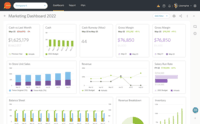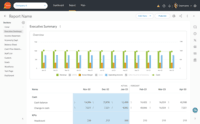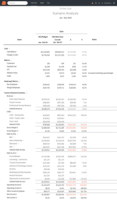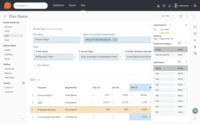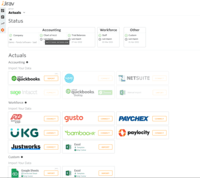Starting at $10,000 per year
View PricingOverview
What is Jirav?
Jirav, headquartered in San Francisco, aims to deliver smarter financials and faster insights, helping to understand where a business has been and predict where it will go. The system joins cloud-based Accounting, HR, CRM and billing data to automatically surface…
Recent Reviews
Pricing
Starter
$10,000
Cloud
per year
Pro
$15,000
Cloud
per year
Enterprise
Contact Sales
Cloud
Entry-level set up fee?
- No setup fee
For the latest information on pricing, visithttps://www.jirav.com/pricing
Offerings
- Free Trial
- Free/Freemium Version
- Premium Consulting/Integration Services
Starting price (does not include set up fee)
- $10,000 per year
Product Demos
Jirav Product Demo
YouTube
How To Set Up Jirav Software's Simplified Financial Reporting
YouTube
Cash Flow Forecasts - How to Build Wealth for Your Business with Jirav
YouTube
Jirav Software Demo Review
YouTube
Product Details
- About
- Integrations
- Competitors
- Tech Details
- Downloadables
- FAQs
What is Jirav?
Jirav is financial modeling software that helps users plan faster. It combines accounting, workforce, and operational data in a driver-based financial model to quickly see where a business has been and accurately forecast where it is going.
Build driver-based financial models
Provides a real-time look at what’s ahead to help uncover new opportunities for growth and profit with a financial model customized to the business. Jirav's financial modeling software eases creating and updating financial forecasts and budgets. Users can build sophisticated plans and models, then make adjustments and automatically roll forward a plan so the user can spend more time on strategy.
Combine financial and operational data
With Jirav’s cloud financial planning and analysis software, users can plan and forecast with consolidated data across the entire organization, not just what’s in the general ledger. Import non-financial metrics and combine with financial data to plan and report on the key performance indicators that matter most to a business, including any custom KPI .
Customize business drivers
From staffing to capital expenditures—there are many unique metrics driving a business. Jirav enables users to create custom drivers with formulas and assumptions to build more accurate forecasts and budgets. Designed to simplify workforce planning and staffing decisions by linking cause and effect, such as outbound sales reps driving new revenue, or revenue driving new hires on the support team. Customize drivers however a business works.
Forecast cash flow
Jirav automatically generates 3-way financial statements for historical and future periods from your model, including Income Statement, Balance Sheet, and Statement of Cash Flows. See the impact of increased/decreased revenue, staffing changes, and capital expenditures. Forecast cash flows 1 month, 6 months, 12 months, or even 60 months in the future. Clone models and tweak key assumptions to see the impact on cash flows over the short and long term.
Project sales and revenue
Simple sales forecasts can be created or sophisticated, industry-specific revenue models can be built using Jirav’s custom tables. Project deferred revenue backlog into a forecast to ensure that a plan is accurate on both a cash and accrual basis.
Planning the workforce
Individual new hires can be planned, or planning can be done formulaically by role with workforce drivers linked to a financial model. Fully-burdened headcount costs can be incorporated into a model including benefits and taxes. Reports include key workforce metrics such as salary run rate, revenue per employee, and percentage of cost of workforce. These KPIs can be visualized in dashboards for department heads.
Budget by department
Budgeting can be done by starting with last year’s numbers or build from scratch. With Jirav, users can forecast based on historical results or budget from the bottom-up by creating drivers linked to planned business activity. Build departmental budgets that roll up automatically into the company plan of record. Create accountability with reports and dashboards customized for the needs of each department head including budget vs forecast vs plan and relevant KPIs.
Modeling capital expenditures
The effect of capital purchases and the related depreciation (using any method) can be modeled on pro forma financial statements. Capital spending drivers can be headcount, production units, or any other metric. For example, a driver can be created to requisition a laptop for each new hire. And if orders increase beyond a set threshold, a new piece of production equipment can be purchased.
Comparing multiple scenarios
Cloning models can create comparisons on the fly for fast scenario planning. Plans can be adjusted or compared on the fly, even in the middle of a board meeting. Budget v. actual, budget v. forecast, or forecast v. actual, or any combination can be compared. They’re all part of the same financial modeling software platform.
Jirav Screenshots
Jirav Videos
Jirav Product Demo
Watch Customer Testimonials
Jirav Integrations
Jirav Competitors
Jirav Technical Details
| Deployment Types | Software as a Service (SaaS), Cloud, or Web-Based |
|---|---|
| Operating Systems | Unspecified |
| Mobile Application | No |
| Supported Countries | United States, Canada |
| Supported Languages | English |
Jirav Downloadables
Frequently Asked Questions
Jirav, headquartered in San Francisco, aims to deliver smarter financials and faster insights, helping to understand where a business has been and predict where it will go. The system joins cloud-based Accounting, HR, CRM and billing data to automatically surface an interconnected model that is unique to a business. The solution helps eradicate spreadsheet errors, produce monthly reports that occur in real-time, and connected data enables teams to collaborate on multiple scenarios – bookings, billing, revenue recognition, cash flow, and workforce/expense planning – to get the answers they need.
Jirav starts at $10000.
The most common users of Jirav are from Small Businesses (1-50 employees).
Jirav Customer Size Distribution
| Consumers | 0% |
|---|---|
| Small Businesses (1-50 employees) | 40% |
| Mid-Size Companies (51-500 employees) | 60% |
| Enterprises (more than 500 employees) | 0% |

